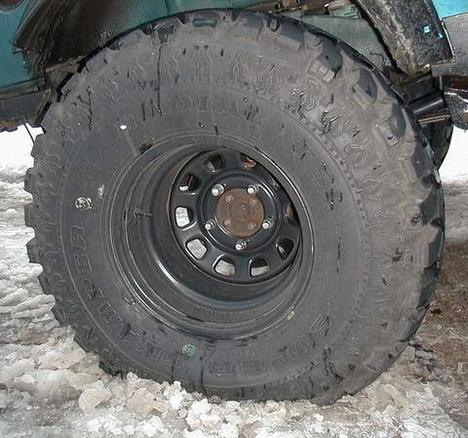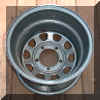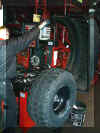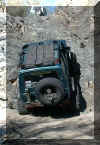
 A
great set of tires needs a great set of wheels. Four-wheel drives in particular
need high-quality wheels since they see much tougher duty than street driven
vehicles. Off-road wheels need to be strong, not only to support the weight of
heavy tires under a heavy truck, but also because of the forces they encounter
on the trail. Bounding through washouts, tearing over rock piles, and squeezing
up against boulders can quickly expose weaknesses in low quality wheels.
A
great set of tires needs a great set of wheels. Four-wheel drives in particular
need high-quality wheels since they see much tougher duty than street driven
vehicles. Off-road wheels need to be strong, not only to support the weight of
heavy tires under a heavy truck, but also because of the forces they encounter
on the trail. Bounding through washouts, tearing over rock piles, and squeezing
up against boulders can quickly expose weaknesses in low quality wheels.
Many off-roaders prefer steel wheels for their resiliency. Hitting a rock when the tires are aired down could cause an aluminum wheel to crack, whereas a steel wheel will just bend. I have repaired bent steel wheels on the trail before with nothing more than a hammer to pound out the dent while the tire was still mounted.
There is also the problem of fitting large tires on the vehicle without them rubbing on the body or suspension components. Different offsets move the tire in or out of the wheel wells, but most off-the-shelf wheels are available with backspacing down to only 3.5 inches. For many vehicles, fitting large tires requires more offset.
For my 33x14.50 Super Swamper SSRs, I acquired a set of 15x10 Series 84 Daytona wheels from U.S. Wheel through Rocky Road Outfitters. They offer six different styles of steel wheels that can be made with custom backspacing in ¼-inch increments all the way down to 2.0 inches. For my application on a Suzuki Samurai, I ordered 2-inch backspacing to keep the Swamper's large TSL shoulder lugs from rubbing on the front leaf springs when the wheels are turned to full lock.
 U.S.
Wheel's custom backspaced wheels are delivered unpainted unless chrome is
ordered at an additional charge. Since my Buster spends much of its time rock
crawling, I prefer paint because it can be easily touched up after scraping
against rocks. Proper preparation of the wheels is necessary for a good-looking,
long lasting finish.
U.S.
Wheel's custom backspaced wheels are delivered unpainted unless chrome is
ordered at an additional charge. Since my Buster spends much of its time rock
crawling, I prefer paint because it can be easily touched up after scraping
against rocks. Proper preparation of the wheels is necessary for a good-looking,
long lasting finish.
 Before
priming and painting the wheels, the metal must be clean and dry. A good
medium-strength, residue-free solvent such as Xylene should be used with a clean
rag to remove every trace of dirt and grease from the surface. Plan to spend a
lot of time on this important step, but please follow the solvent's directions
to use gloves to protect your skin from the chemicals, which I failed to do.
Before
priming and painting the wheels, the metal must be clean and dry. A good
medium-strength, residue-free solvent such as Xylene should be used with a clean
rag to remove every trace of dirt and grease from the surface. Plan to spend a
lot of time on this important step, but please follow the solvent's directions
to use gloves to protect your skin from the chemicals, which I failed to do.
 The
paint will not stick well without a couple of thin coats of high-quality primer
on the steel. The primer will not stick if the solvent has not completely
evaporated though, so do not rush into applying the primer. Primer is very soft;
do not apply a thick layer of it below the paint or the paint will flake and
chip. Making sure that I primed every crevice of the four large wheels with two
thin coats, I emptied three spray cans of primer.
The
paint will not stick well without a couple of thin coats of high-quality primer
on the steel. The primer will not stick if the solvent has not completely
evaporated though, so do not rush into applying the primer. Primer is very soft;
do not apply a thick layer of it below the paint or the paint will flake and
chip. Making sure that I primed every crevice of the four large wheels with two
thin coats, I emptied three spray cans of primer.
 After
allowing the primer to cure overnight, I then spent the next day carefully
spraying five cans of gloss black onto the wheels. Follow the instructions on
the cans of paint for the best results, but be sure to allow plenty of time for
previous coats to dry before spraying more coats.
After
allowing the primer to cure overnight, I then spent the next day carefully
spraying five cans of gloss black onto the wheels. Follow the instructions on
the cans of paint for the best results, but be sure to allow plenty of time for
previous coats to dry before spraying more coats.
The paint I used dries to the touch fairly quickly, but requires a couple of days to reach full hardness. I'd recommend not mounting your tires for a few days because the partially cured paint may not hold up well to the mounting and balancing machines. I was in a rush to get the tires and wheels on my truck, however, so the technicians at my favorite local tire store did a great job of being careful about the wheels' still-soft paint.
 I
had the wheels and tires mounted and balanced at America's Tire in Pleasant
Hill, California. They have always done a good job in the past and I was again
pleased with their work. I saw firsthand how difficult it can be to get such
large tires mounted; seating the beads took teamwork and gave the air compressor
a workout.
I
had the wheels and tires mounted and balanced at America's Tire in Pleasant
Hill, California. They have always done a good job in the past and I was again
pleased with their work. I saw firsthand how difficult it can be to get such
large tires mounted; seating the beads took teamwork and gave the air compressor
a workout.
 Each
wheel and tire combination weighs over 100 pounds. Balancing such large, heavy
assemblies oftentimes requires a lot of balancing weights. I was impressed with
how little weight was required on the first three I balanced, needing only 3, 6,
and 8 grams to balance. The last tire and wheel took 12 grams of weight. I
considered remounting the tire 180 degrees off, but after I got them balanced I
felt no vibrations so I called that job finished.
Each
wheel and tire combination weighs over 100 pounds. Balancing such large, heavy
assemblies oftentimes requires a lot of balancing weights. I was impressed with
how little weight was required on the first three I balanced, needing only 3, 6,
and 8 grams to balance. The last tire and wheel took 12 grams of weight. I
considered remounting the tire 180 degrees off, but after I got them balanced I
felt no vibrations so I called that job finished.
 For
best balance, weights should be clipped to both the inside and outside edges of
the wheels. However, on vehicles that do a lot of rock crawling, the outer
weights do not stay in place for long; rocks tear them right off so the ride
home from the trail vibrates the passengers' fillings loose until the wheels
are re-balanced. The outer rim of the old wheels from Project Buster were chewed
to pieces yet the wheels stayed balanced, so I again had the balancing weights
only clipped to the inner rim on these new wheels. After all, they would be
seeing even tougher trails in the near future.
For
best balance, weights should be clipped to both the inside and outside edges of
the wheels. However, on vehicles that do a lot of rock crawling, the outer
weights do not stay in place for long; rocks tear them right off so the ride
home from the trail vibrates the passengers' fillings loose until the wheels
are re-balanced. The outer rim of the old wheels from Project Buster were chewed
to pieces yet the wheels stayed balanced, so I again had the balancing weights
only clipped to the inner rim on these new wheels. After all, they would be
seeing even tougher trails in the near future.
 The
old 33x12.50's were mounted on 15x8 wheels with 2 ¾-inch backspacing for a
very wide stance. The combination of the 2-inch greater width and ¾-inch less
backspacing of these new wheels pushes the outer edge 2 ¾ inches further out on
each side, for a total of 5 ½ inches wider wheel-to-wheel.
The
old 33x12.50's were mounted on 15x8 wheels with 2 ¾-inch backspacing for a
very wide stance. The combination of the 2-inch greater width and ¾-inch less
backspacing of these new wheels pushes the outer edge 2 ¾ inches further out on
each side, for a total of 5 ½ inches wider wheel-to-wheel.
 The
moment I backed the Suzuki out of the shop with the new wheels and tires
mounted, I were very impressed with its looks. Even with 3-inch fender flare
extensions, the tires are not even close to being fully covered by the body.
From tire to tire, the track width of the Samurai is now 14 inches greater than
a stock Samurai. Simply put, it looks cool.
The
moment I backed the Suzuki out of the shop with the new wheels and tires
mounted, I were very impressed with its looks. Even with 3-inch fender flare
extensions, the tires are not even close to being fully covered by the body.
From tire to tire, the track width of the Samurai is now 14 inches greater than
a stock Samurai. Simply put, it looks cool.
Wide stance is about much more than just good looks, however. Two-inch backspacing of the wheels is just perfect for fitting tires this large on a Suzuki. At full steering lock, the front tire's big shoulder lugs have just the right clearance at the leaf springs. As a result, the Samurai's tight turning circle is retained despite the size of the tires.
 Another
benefit of custom backspacing is the steering arc that the front wheels follow.
The Samurai's stock wheel offset puts the steering axis near the center of the
front tires' contact patches. That, combined with the light weight and the
small size of stock Samurai tires means that having no power steering isn't a
problem, even in parking-lot maneuvers. However, larger tires grip better,
increasing steering effort substantially. Project Buster's new Super Swampers
are enormous, yet the steering effort is light - even on pavement at a dead stop
- because the wheel offset puts the center of the steering axis at the inside
edge of the tire. As a result, the front tires roll forward and backward as they
steer, reducing steering effort substantially.
Another
benefit of custom backspacing is the steering arc that the front wheels follow.
The Samurai's stock wheel offset puts the steering axis near the center of the
front tires' contact patches. That, combined with the light weight and the
small size of stock Samurai tires means that having no power steering isn't a
problem, even in parking-lot maneuvers. However, larger tires grip better,
increasing steering effort substantially. Project Buster's new Super Swampers
are enormous, yet the steering effort is light - even on pavement at a dead stop
- because the wheel offset puts the center of the steering axis at the inside
edge of the tire. As a result, the front tires roll forward and backward as they
steer, reducing steering effort substantially.
The greatest benefit to the new, wide stance is the stability it affords on the trail in off-camber situations. The combination of the wide offset and heavy tire/wheel weight keeps the tires firmly planted on the ground and more than makes up for the higher center of gravity from the vehicle's lift.
 During
my testing, I beat the tires and wheels as hard as I could. The outer rims of
the wheels are scraped and gouged from rocks, but they have held up well to the
abuse. The only paint that has come off the wheels was left behind on rocks; the
finish still looks as good as new, except for the chewed up outer rims.
During
my testing, I beat the tires and wheels as hard as I could. The outer rims of
the wheels are scraped and gouged from rocks, but they have held up well to the
abuse. The only paint that has come off the wheels was left behind on rocks; the
finish still looks as good as new, except for the chewed up outer rims.
Rocky Road Outfitters is the only online source for custom backspaced wheels, and they make it easy to order a set of quality wheels that is customized to your own vehicle's needs. Prices vary by size and style, but are reasonable across the board and are available for any vehicle.


 Your Privacy Choices
Your Privacy Choices